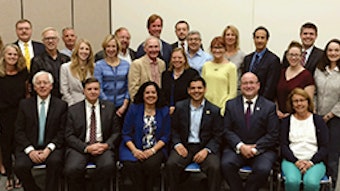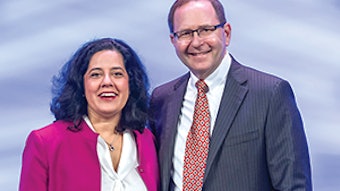Annual Report 2016: Research & Quality
Build a sustainable infrastructure to test, pilot, and promote adoption of research and quality products including guidelines, measures, performance improvement projects or lifelong learning projects, and evidence-based medicine to promote translational research.
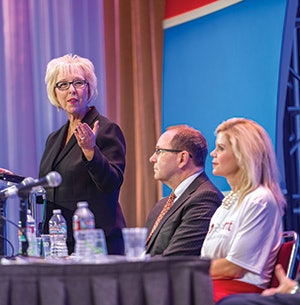 H. Louise Eddy, MS, CCC/A, FAAA, executive director of Texas Ear, Nose & Throat Specialists, P.A., Houston, TX, presented during the Annual Meeting Miniseminar, “The Future Is Now, Regent: The First Otolaryngology-Specific Clinical Data Registry.”
H. Louise Eddy, MS, CCC/A, FAAA, executive director of Texas Ear, Nose & Throat Specialists, P.A., Houston, TX, presented during the Annual Meeting Miniseminar, “The Future Is Now, Regent: The First Otolaryngology-Specific Clinical Data Registry.”Research & Quality strategic goals include:
- Develop and maintain a clinical data registry for the specialty.
- Build a sustainable infrastructure to test, pilot, and promote adoption of research and quality products including guidelines, measures, appropriate use criteria, performance improvement projects or lifelong learning projects, and evidence-based medicine to promote translational research.
- Demonstrate the value of strong research and quality education and granting programs to the specialty.
Develop and maintain a clinical data registry for the specialty.
REGENT℠ REGISTRY: DEVELOPMENT AND OVERSIGHT
Since the approval by the Board of Directors to move forward with the registry in September 2015, we have made tremendous progress in a short period of time. The listing below highlights our progress since December 2015.
- AAO-HNSF secured both Qualified Clinical Data Registry and PQRS Qualified Registry status from CMS for Regent in April 2016.
- The pilot phase of Regent concluded in June, with 21 pilot sites and 298 individual participants from five academic sites, 16 private practices, and 12 different EHR systems.
- The Regent full launch sign-up portal deployed in July. This sign-up portal includes functionality to guide enrollees through the sign up, contracting, and membership verification processes.
- Regent launched to the full membership July 25, 2016.
- As of October, Regent includes more than 245 practice sites and close to 2,000 clinicians.
- Each practice site reviews its measures data for accuracy with FIGmd and AAO-HNSF staff.
- Concurrently, review has commenced on all of the ICD9 and 10 and CPT codes for all Regent measures to ensure the accuracy of data contained in Regent.
- Registry Dashboards are being made available as data mapping exercises are finalized with each participating practice.
- AAO-HNSF is preparing for PQRS 2016 reporting and MIPS 2017 as well as securing QCDR status for Regent in 2017.
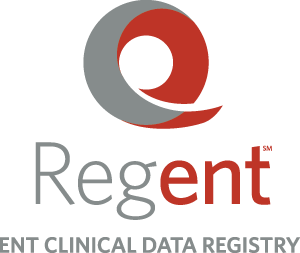
GUIDELINE UPDATES
To date, the AAO-HNSF clinical practice guidelines (CPG) have been accessed close to 600,000 times via the National Guideline Clearinghouse and cited more than 4,000 times, according to Google Scholar. This is amazing outreach for such a small specialty. We are in the final stages of four updates and two new CPGs.
- The update to the 2004 Otitis Media with Effusion CPG was published February 2016 and has been endorsed by the American Academy of Family Physicians (AAFP).
 “Harness the power of data”
“Harness the power of data”
The coming year will bring an update to Tonsillectomy in Children and new guidelines on Meniere’s Disease and the Surgical Management of Rhinosinusitis.
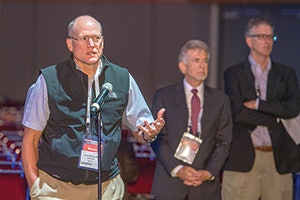 Attendees asked questions during the Miniseminar on Regent.
Attendees asked questions during the Miniseminar on Regent.GUIDELINE EDUCATION
This year marks the launch of the new Expert Interview Series (AmX), which will offer 5-10 CME credits to users. The Rhinoplasty, Cerumen, and BPPV guideline Miniseminars have been selected for development into this new product and will be launched in early 2017.
MEASURING GUIDELINE ADHERENCE
As the AAO-HNSF looks to develop quality measures to help Members meet the ever-increasing demands of the Centers for Medicare & Medicaid Services (CMS) and other payers, it is important for us to look more closely at the quality improvement opportunities identified in the CPGs and see where there may be performance gaps that can be targeted for future quality improvement efforts and measure development. The Outcomes, Research, and Evidence-based Medicine (OREBM) Committee and the Creating Healthcare Excellence through Education and Research (CHEER) Network have been working on providing us with this evidence and published the following studies earlier this year:
- Evaluation of Compliance for Treatment of Sudden Hearing Loss: A CHEER Network Study (July 2016)
- Tonsillectomy Bleed Rates across the CHEER Practice Research Network: Pursuing Guideline Adherence and Quality Improvement (July 2016)
- Multi-institutional Study of Voice Disorders and Voice Therapy Referral: Report from the CHEER Network (July 2016)
- Medications for Allergic Rhinitis: An Opportunity for Quality Improvement? (August 2016)
- Nonadherence to Guideline Recommendations for Tympanostomy Tube Insertion in Children Based on Mega-database Claims Analysis (September 2016)
DEVELOPING QUALITY MEASURES
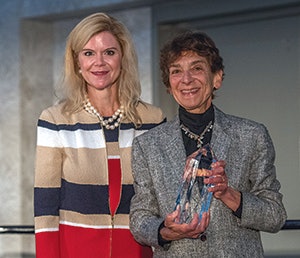 Dr. Lisa Ishii with Dr. Martha Somerman, this year’s H. Bryan Neel III, MD, PhD Distinguished Research Lecturer.
Dr. Lisa Ishii with Dr. Martha Somerman, this year’s H. Bryan Neel III, MD, PhD Distinguished Research Lecturer.In conjunction with the work on Regent, staff and physician leaders have reviewed our measures and have worked on a quality measures development strategy to guide our work and to ensure it is inclusive of all of the disease processes treated by our Members with the goal to ensure the development of meaningful measures addressing the depth and breadth of care provided by our Members.
Measures development governance:
- The Academy developed a preliminary measures development strategy built upon the operations of four distinct groups: Regent Executive Committee, Clinical Advisory Committees (CACs), Measure Development Groups (MDGs), and the Measures Task Force (MTF) to develop measures for the specialties of otolaryngology-head and neck surgery.
- Seven individual CACs were created by the Regent Executive Committee (REC) to address measure development needs of each of the otolaryngology specialties. Clinical Advisory Committees comprise experts from Academy committees, specialty societies, and stakeholder groups and are chaired by the following REC representatives:
- Facial Plastics – Lisa E. Ishii, MD, MHS, chair
- General & Sleep – Lauren S. Zaretsky, MD, chair
- Head & Neck – Michael G. Glenn, MD, chair
- Hearing & Balance Chair – James C. Denneny III, MD, chair
- Pediatrics – Jennifer J. Shin, MD, SM, chair
- Sinus & Allergy – William R. Blythe, MD, chair
- Voice & Swallowing – Melissa A. Pynnonen, MD, chair
- Measures Development Groups will be formed to complete the specific task of fully developing quality and performance measures for a specific disease, condition, or procedure.
- The Measures Task Force is a standing task force comprising various methodological experts, Academy measures staff, and stakeholders who have specialized knowledge or perspectives relevant to the work of MDGs, and will be chaired by Richard M. Rosenfeld, MD, MPH, Senior Advisor on Measures. During the AAO-HNSF Annual Meeting and OTO EXPO,℠ 31 potential measure topics were identified by the CACs for prioritization.
- The Academy is collaborating with the ECRI Institute to pilot test its GEM Cutting software using our Allergic Rhinitis and Cerumen Impaction guidelines. The Academy will evaluate whether GEM Cutting allows for expedited translation of guidelines into performance measures and assess the quality of the guidelines-based measures developed.
- The Academy will also be collaborating with the American Academy of Neurology (AAN) regarding the development of neurotology measures.
Demonstrate the value of strong research and quality education and granting programs to the specialty.
GRANT FUNDING
The AAO-HNSF is pleased to continue its partnership with the American Academy of Otolaryngic Allergy (AAOA), American Head and Neck Society (AHNS), American Rhinologic Society (ARS), American Society of Pediatric Otolaryngology (ASPO), Association of Migraine Disorders (AMD), and American Academy of Facial Plastic and Reconstructive Surgery (AAFPRS) as part of the Centralized Otolaryngology Research Efforts (CORE) Grant Program.
Special thanks to Cook Medical and Xoran Technologies LLC for their continued financial support of resident research.
The CORE Study Section continues to provide a comprehensive review of all otolaryngology applications and provides scores and written critiques to the leadership of the participating societies to help inform their funding decisions. The 2016 CORE leadership (including the boards and councils of all participating societies) approved a portfolio of 29 grants totaling $495,195.
MOVING RESEARCH INTO PRACTICE
Earlier this year, the OREBM committee kicked off a new column in the Bulletin, “Publications That May Change Your Practice: Spotlight from the OREBM Committee.” The goal of the column is to highlight important research and how the new studies may change how one practices. In March 2016, the column compared elective neck dissection (END) to therapeutic neck dissection (TND) in patients with early-stage (T1-2), node-negative oral cavity squamous cell carcinoma (OSCC). In September, the highlighted publications presented data regarding management of uncomplicated acute rhinosinusitis (ARS) and recurrent acute rhinosinusitis (RARS) in adults. The next installment will focus on an endocrine topic.

